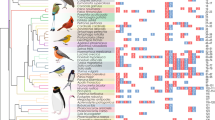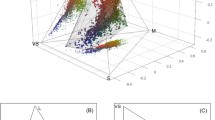Summary
In the monogamous least auklet (Aethia pusilla, Alcidae) both males and females have three highly variable ornamental traits (facial plumes, a colourful bill and a knob-like bill ornament) and both sexes perform courtship displays. To assess whether mating preferences could be related to the expression of these ornaments, we performed model presentation experiments in which we varied the bill colour and the size of both the bill ornament and the facial plumes. Auklets reacted to models that had brighter red bills and accentuated facial plumes with more frequent sexual displays than to models with average bills and plumes. We conclude that these two ornamental traits are likely to be favoured by sexual selection through mating preferences. In general, however, ornaments were weak predictors of individual quality. Multiple regression indicated that all ornaments taken together explained a small (R 2 = 0.07) but significant proportion of the variability in adult body condition but only in a poor year for reproduction when the birds were in relatively poor body condition and a small proportion of the population bred successfully. The degree of ornamentation was also not related to timing of breeding, chick feeding rate or reproductive success and there was no relationship between adult survival and ornaments. We conclude, therefore, that least auklet ornaments are, at best, weak indicators of quality that may be the result of sexual selection operating only in years when breeding conditions are poor.
Similar content being viewed by others
References
Alatalo RV, Höglund J, Lundberg A (1988) Patterns of variation in tail ornament size in birds. Biol J Linn Soc 34:363–374
Andersson M (1982a) Female choice selects for extreme tail length in a widowbird. Nature 299:818–820
Andersson M (1982b) Sexual selection, natural selection and quality advertisement. Biol J Linn Soc 17:375–393
Andersson M (1986) Evolution of condition-dependent sex ornaments and mating preferences: sexual selection based on viability differences. Evolution 40:804–816
Barnard P (1990) Male tail length, sexual display intensity and female sexual response in a parasitic African finch. Anim Behav 39:652–656
Bédard J, Sealy SG (1984) Moults and feather generations in the least, crested and parakeet auklets. J Zool 202:461–488
Birkhead TR (1985) Extra-pair matings and mate-guarding in the common murre Uria aalge. Anim Behav 33:608–619
Burley N (1981) The evolution of sexual indistinguishability. In: Alexander RD, Tinkle DW (eds) Natural selection and social behaviour: recent research and new theory. Chiron Press, New York, pp 121–137
Darwin C (1871) The descent of man and selection in relation to sex. Murray, London
Dixon WJ (1985) BMDP statistical software. University of California Press, Berkeley
Fisher RA (1930) The genetical theory of natural selection. Clarendon Press, Oxford
Grafen A (1990a) Sexual selection unhandicapped by the Fisher process. J Theor Biol 144:473–516
Grafen A (1990b) Biological signals as handicaps. J Theor Biol 144:517–546
Grant PR, Abbott I, Schluter D, Curry RL, Abbott LK (1985) Variation in the size and shape of Darwin's finches. Biol J Linn Soc 25:1–39
Hamilton WD, Zuk M (1982) Heritable true fitness and bright birds: A role for parasites. Science 218:384–387
Heisler IL (1984) A quantitative model for the origin of mating preferences. Evolution 38:1283–1295
Heywood JS (1989) Sexual selection by the handicap mechanism. Evolution 43:1387–1397
Hill GE (1990) Female house finches prefer colourful males: Sexual selection for a condition-dependent trait. Anim Behav 40: 563–572
Huxley JS (1914) The courtship habits of the great crested grebe Podiceps cristatus; with an addition to the theory of sexual selection. Proc Zool Soc Lond 35:491–562
Jones IL (1990a) Plumage variability functions for status signalling in least auklets. Anim Behav 39:967–975
Jones IL (1990b) Status signalling, sexual selection and the social signals of least auklets Aethia pusilla. Ph D dissertation, Queen's University, Kingston
Jones IL, Montgomerie RD (1991) Mating and re-mating of least auklets (Aethia pusilla) relative to ornamental traits. Behavioural Ecology 2:249–257
Jones IL (1992) Colony attendance of least auklets Aethia pusilla at St. Paul Island, Alaska: implications for population monitoring. Condor, in press
Kirkpatrick M (1982) Sexual selection and the evolution of female choice. Evolution 36:1–12
Kirkpatrick M, Price T, Arnold SJ (1990) The Darwin-Fisher theory of sexual selection in monogamous birds. Evolution 44:180–193
Kundtson EP, Byrd GV (1982) Breeding biology of crested, least and whiskered auklets at Buldir Island, Alaska. Condor 84:197–202
Kodric-Brown A, Brown JH (1984) Truth in advertising: the kinds of traits favoured by sexual selection, Am Nat 124:309–323
Lande R (1981) Models of speciation by sexual selection on polygenic traits. Proc Nat Acad Sci 78:3721–3725
McArdle BH (1988) The structural relationship: regression in biology. Can J Zool 66:2329–2339
Møller AP (1988) Female choice selects for male sexual tail ornaments in the monogamous swallow. Nature 332:640–642
Piatt J, Roberts B, Lidster W, Wells J, HatchS (1990) Effects of human disturbance on breeding least and crested auklets at St. Lawrence Island, Alaska. Auk 107:342–350
Pomiankowski AN (1988) The evolution of female mate preference for male genetic quality. Oxford Survey in Evol Biol 5:136–184
Rice WR (1989) Analyzing tables of statistical tests. Evolution 43:223–225
Rising JD, Somers KM (1989) The measurement of overall body size in birds. Auk 106:666–674
Roby DD, Brink KL (1986) Breeding biology of least auklets on the Pribilof Islands, Alaska. Condor 88:336–346
Smith H, Montgomerie RD (1991) Sexual selection and the tail ornaments of North American barn swallows. Behav Ecol Sociobiol 28:195–201
Smithe FB (1975) Naturalist's colour guide. American Museum of Natural History, New York
Springer AM, Roseneau DG (1985) Copepod-based food webs: auklets and oceanography in the Bering Sea. Mar Ecol Progr Ser 21:229–237
von Schantz T, Göransson G, Andersson G, Fröberg I, Grahn, Helgée M, Wittzell H (1989) Female choice selects for a viability-based male trait in pheasants. Nature 337:166–169
Zahavi A (1975) Mate selection — a selection for a handicap. J Theor Biol 53:205–214
Zar JH (1984) Biostatistical analysis, 2nd Edn. Prentice-Hall, Englewood Cliffs, New Jersey
Author information
Authors and Affiliations
Additional information
Offprint requests to: R. Montgomerie
Rights and permissions
About this article
Cite this article
Jones, I.L., Montgomerie, R. Least auklet ornaments: do they function as quality indicators?. Behav Ecol Sociobiol 30, 43–52 (1992). https://doi.org/10.1007/BF00168593
Received:
Accepted:
Issue Date:
DOI: https://doi.org/10.1007/BF00168593




